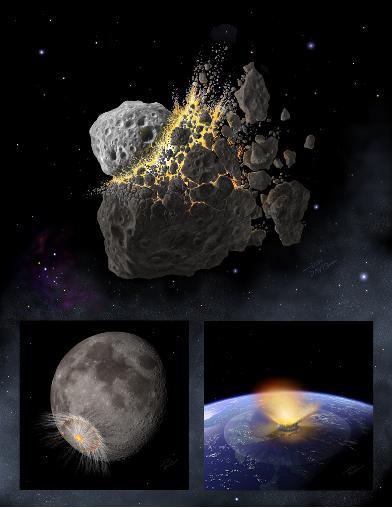This is a fragment with a diameter of several kilometers from a giant asteroid that broke up 160 million years ago * Most of the fragments continue in the original and largest orbit in which it was nicknamed Baptistina * According to a simulation conducted by researchers - some of the fragments escaped from the same orbit - one of them collided with the Earth and another created the Tycho crater on the moon

This is how the Earth and the Moon were damaged by asteroid fragments that were ejected after hitting a giant asteroid
When it was proposed, not many years ago, the theory was considered controversial, but today most researchers in the field of paleontology support the theory that a large asteroid hit the Earth 65 million years ago and caused a relatively short chain of events of fires, volcanic eruptions, and obscuring sunlight, which brought the kidney on 90 percent of the species that lived on Earth, led by the dinosaurs, after a prosperity that lasted for about 180 million years. Astronomers now claim to have traced the origin of the object that hit a large asteroid millions of years ago, creating many fragments, some of which hit Earth and the Moon.
In an article published by a joint group of scientists from the United States and the Czech Republic, they proposed a theory that the parent bone of asteroid 298 Baptista was disrupted when it was struck by another large asteroid, tearing off large chunks that later formed the Chicxulub Crater on the Yucatan Peninsula, as Also the Tycho crater on the moon.
The team of researchers, from the Southwestern Institute in the US and Charles University in Prague, combined observations from several computer simulations to try to understand how the impact on the Patistina asteroid occurred as well as the chain of events that followed. In particular, the researchers focus on the question of how the fragments of Baptistina affected the Earth and the Moon. The article was published in the September 6 issue of the journal Nature.
Baptistina's parent body was a 170-kilometer-diameter body with maffins similar to meteorites composed mostly of carbon called chondrites, orbiting the Sun in the inner part of the asteroid belt when it was struck by another 60-kilometer-diameter asteroid. The impact created the Baptistina family of asteroids, a cluster of asteroid fragments that mostly follow an orbit close to the orbit of the main asteroid. According to the model developed by the researchers, this family includes about 300 bodies with a diameter of more than 10 kilometers and 140 thousand bodies larger than one kilometer.
After this family was created, the shards began to slowly develop somewhat independent paths due to the heat forces on them due to the absorption of sunlight and radiating back the energy in the form of heat. According to Dr. William Butka, from the Southwest Research Institute, "by building a careful model of the phenomenon and the distance swallowed by lumps of different sizes from the area where the collision occurred. "We estimate that the breakup of Baptistina happened 160 million years ago, plus or minus 20 million years."
The gradual dispersal of fragments from the Baptistina family caused many fragments to drift into an orbit in space through which they could escape the central asteroid belt and reach orbits crossing the Earth's orbit. The team's calculations showed that about 20% of fragments several kilometers long or more were lost this way, with two percent of these objects hitting Earth and creating some of the largest asteroid impacts on Earth.
Support for these calculations comes from the vulnerability history of the Earth and the Moon, both of which appear to have increased cratering in the last 100-150 million years. The peak of Baptistina debris impacts occurred 100 million years ago. This is consistent with our knowledge of the vulnerability history"
The team investigated the origin of the 180-kilometer-diameter crater in the Yucatan that was linked to the time when the dinosaurs were extinct, 65 million years ago. A study of sediment samples showed that the layer is filled with carbonaceous chrontride compounds similar to the primitive meteorite known from Archison. This composition is enough to rule out many possible attackers except the family of myself in Patistina. They entered this figure into the simulation and found that there is a 90% chance that the objects that created the Chikholov Crater are refugees of this family.
Other recent news in the field
Justice friend or foe (Is Jupiter's presence as a cosmic vacuum cleaner essential to protecting the inner solar system from more frequent asteroid strikes)
Proposal: launch a spacecraft to asteroid Apophis

3 תגובות
What's going on
Correction of the data. According to the article in Universe Today:-
This impact created the Baptistina family, and originally contained 300 objects larger than 10 km, and 140,000 objects larger than 1 km
That is, 300 asteroids with a diameter greater than ten kilometers were created, and another one hundred and forty thousand asteroids with a diameter of over one kilometer. And not as it is said in the translation in knowledge.
Sabdarmish Yehuda